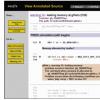 |
Telling It Like It Is: Test Status Reports as Tools for Change Producing regular test status reports makes your progress—and problems—visible to those outside your group. Here's how spending a couple of hours a week on gathering and reporting results can be crucial to your software development team's success.
|
|
|
|
Release Criteria: Is This Software Done? For any project, the big question is: "Is this software ready to release yet?" Explore how to answer that question with confidence, by learning how to define success and how to gain consensus on release criteria.
|
|
|
|
Don't Use Bug Counts to Measure Testers Cem Kaner tells us why we should not use bug counts to measure testers. Using examples, he illustrates two problems: 1) bug counts are poor measures of individual performance; and 2) the side effects of using bug counts as a measure are serious.
|
|
|
|
No More Whining Johanna Rothman urges test managers to stop whining and deal with the "Not-Enough" problem. She concludes: "You have more capability to influence attitudes, behaviors, and actions in your organization than you know. If you feel like a second-class citizen, reframe the situation. Rethink your job and how you do it, and realize the importance of the contribution–finite, but powerful–you can make toward your organization's product quality."
|
|
|
|
A Test Manager's Resource Bank Despite the importance of general management topics, I'm going to stay away from them. There's too much out there, and I know too little about it. Instead, I'll concentrate on what's special about the job of managing testers and the test process.
|
|
|
|
Techniques for Recruiting and Retaining Testers Are you challenged with having to hire people when your budget is limited, time constraints are tight, and the testing effort is overwhelming? Many of us have faced these situations. In this article, Jack Cook shares some techniques that have proven effective in recruiting and retaining testers.
|
|
 |
Managing the End Game: Avoiding End-of-Project Complications by putting the Test Team in Charge Experiencing end-of-project woes? Read how one test team guided the work at the end of a project by establishing daily goals to meet weekly objectives; by grading the product with a two-tiered approach; and by posting frequent status reports.
|
|
|
|
Nightly Builds: A Tester's Early Warning System We're all looking for an effective "Distant Early Warning" line of testing: a procedure that will minimize integration bugs, reduce the risk of low quality by allowing bugs to be caught early, make it easier to debug, and improve the visibility of the status of the system under test. One practice that meets those needs is the "nightly"—essentially a daily build and sanity test of the product.
|
|
 |
A Look at PREfix by Intrinsa PREfix provides a source code simulation tool that is able to perform automatic review for a wide range of programming defects that lead to program crashes. Defects reported by PREfix include de-referencing NULL pointers, using uninitialized memory, leaking memory or resources, or using illegal values. Here is an analysis of the product.
|
|
|
|
The Power Loss Trap In order to be effective, Testing must co-exist on a level playing field with Development and Project Management. It cannot be subservient to them. A test lead's authority on a project springs from his or her projected sense of self-confidence in the role, and the Power Loss Trap undermines this authority. Here are a few commonsense ways to protect yourself.
|
|

